Last updated on June 25th, 2025 at 10:51 am
What are the characteristics of the consumers that you regularly see in your current work environment? What are some ways in that they are impacted by the other identified healthcare stakeholders?
Organizational Strategies
Assignment
- What are the characteristics of the consumers that you regularly see in your current work environment? What are some ways in that they are impacted by the other identified healthcare stakeholders?
- What effect has ACA had on stakeholders? Explain what strategies a nurse leader might adopt that would make it more effective?
- What is important for nurse leaders to share with their staff regarding payers? Why?
- Who are the various regulators that affect your healthcare organization? What is your role in the respective regulatory process?
This PowerPoint® (Microsoft Office) or Impress® (Open Office) presentation should be a minimum of 20 slides, including a title and reference slide, with detailed speaker notes on content slides. Use at least four scholarly sources.
Expert Answer and Explanation
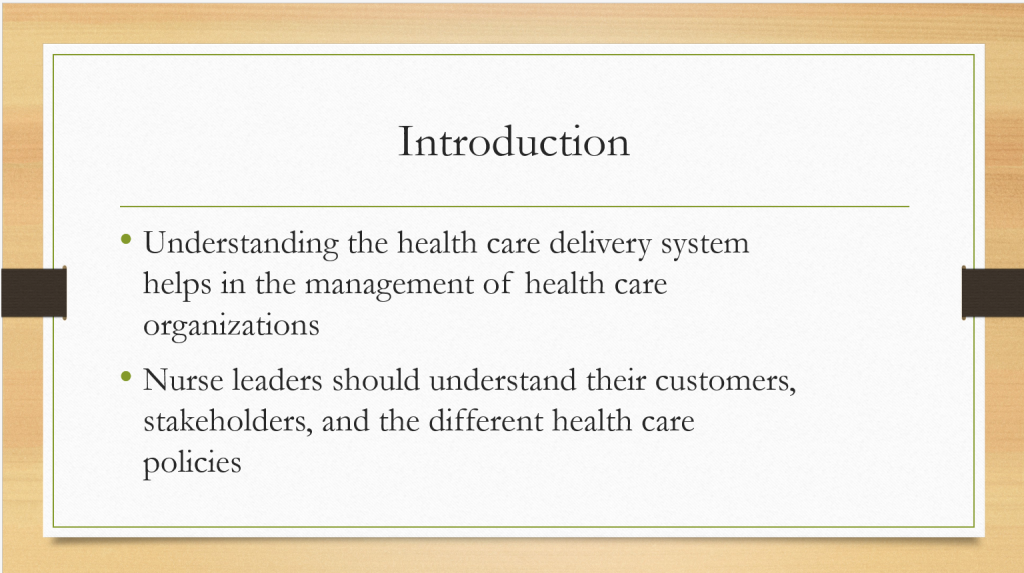
Understanding the health care delivery system is important, especially by a nurse leader. The ability to properly manage health care organizations is dependent on this understanding. A nurse leader needs to understand the nature of customers they serve, how different health care policies affect the and in extension, how the different stakeholders impact their role when delivering health care services to patients.
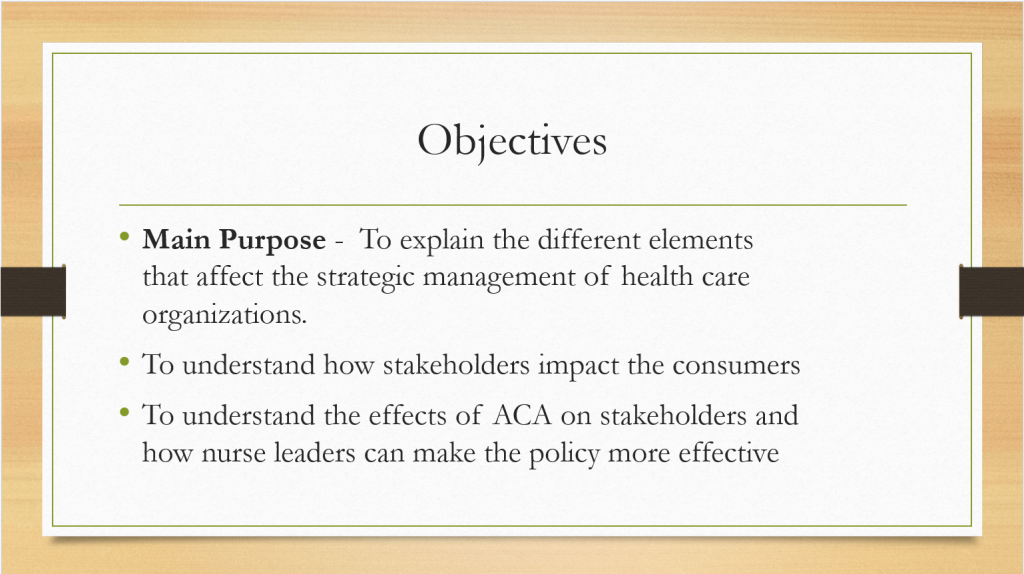
The purpose of this presentation will be to explain the different elements that affect the strategic management of health care organizations.
The individual objectives that will be used to guide the presentation include the following;
- To understand how stakeholders impact the consumers
- To understand the effects of ACA on stakeholders and how nurse leaders can make the policy more effective
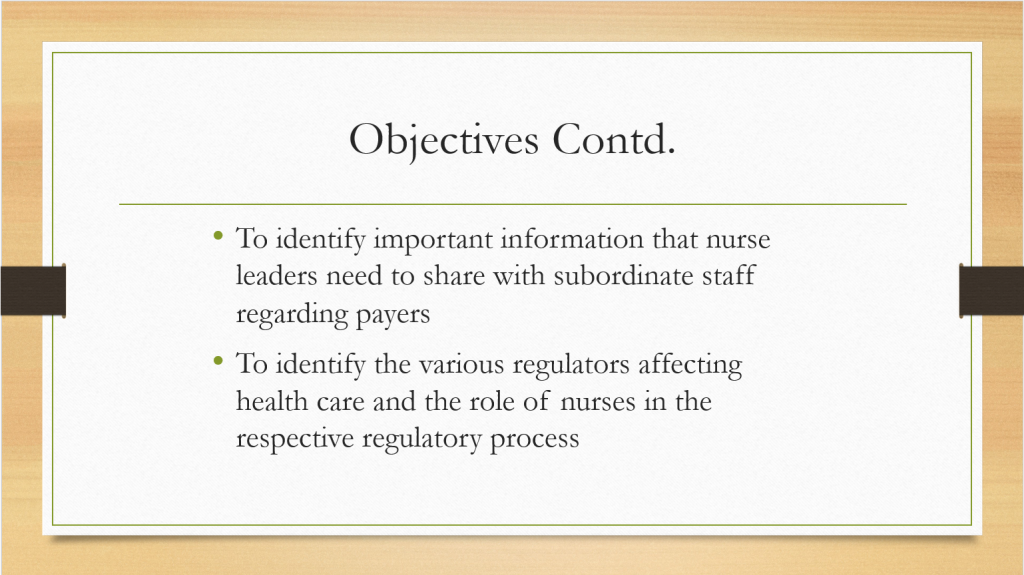
- To identify important information that nurse leaders need to share with subordinate staff regarding payers
- To identify the various regulators affecting healthcare and the role of nurses in the respective regulatory process
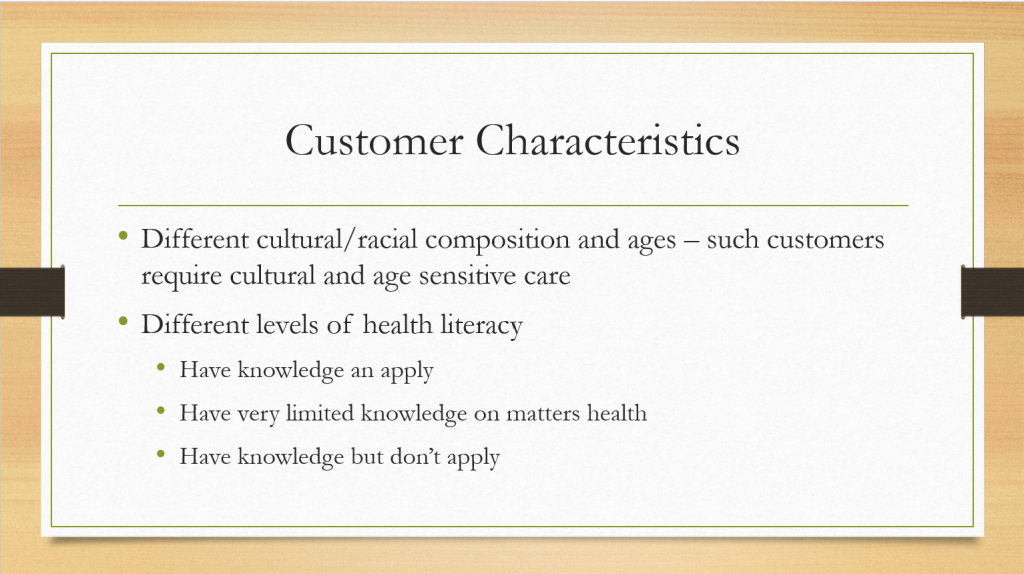
In health care, patients are regarded as the primary customers. In a study by Mazurenko et al. (2016), it was noted that most care providers didn’t initially consider patients as customers, however, with the evolution of health care and inclusion of patient satisfaction as a part of the performance metric, the view of patients as customers started being embraced. One of the elements to ensure customer satisfaction is to first understand the nature of customers being served. In a primary health care facility, the customers being served come from diverse backgrounds. The customers can be regarded from the following perspectives
Racial and age backgrounds – One of the characteristics of customers served in a primary health care facility are patients coming from different cultural/racial backgrounds and from different ages. Such customers require to be given cultural and age sensitive care (Purnell & Fenkl, 2019) .
The customers severed also have different levels of knowledge on matters health. Among this group of patients, there are those who are health savvy, meaning that they have knowledge on different aspects surrounding their state of health and apply the same knowledge to improve their health There are also those who have very limited knowledge or non at all on matters health. And lastly there are those who have some knowledge but fail to apply it to improve their health.
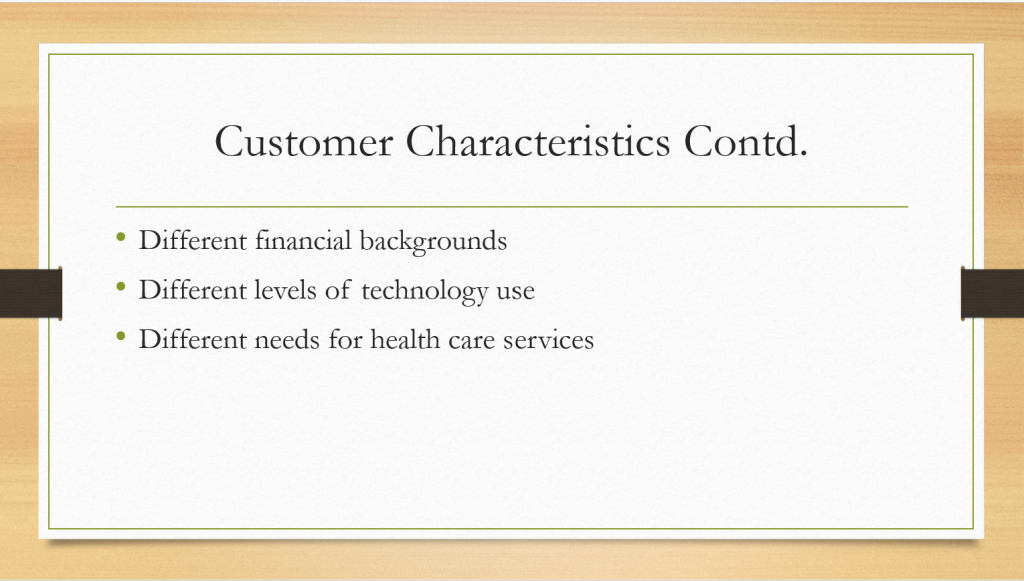
The health care facility also serves customers with different financial capabilities, given that it is a public care facility, there is usually no discrimination, plus most of the care cost for those who are financially unable are catered for by Medicaid coverage.
With the inclusion of technology in care delivery, we also deal with customers how have different levels of knowledge on technology use which usually determines the level of technology inclusion in their care delivery package.
The last characteristic of customers served is that they all have different health care conditions and some have not at all, instead they come for various consultation services.
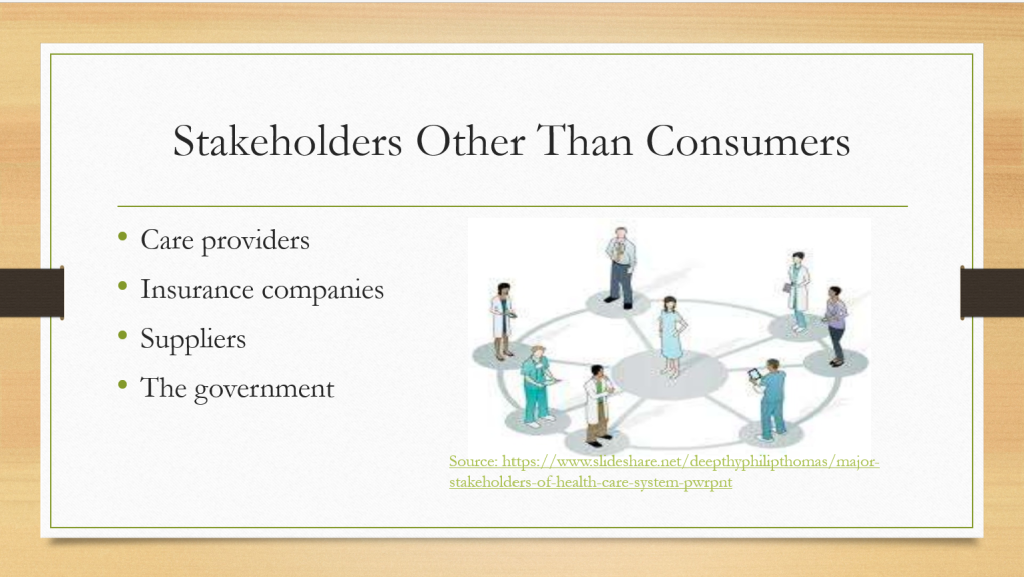
Other than consumers, a health care facility has other stakeholders who impact the services offered. Some of the other stakeholders according to Leger and Dunham-Taylor (2018) include;
- Care providers (physicians, nurses, pharmacists, etc.)
- Insurance companies (providers of health care covers to consumers)
- Suppliers (including pharmaceutical companies, health care technology companies, among others)
- The government (local, state and federal)
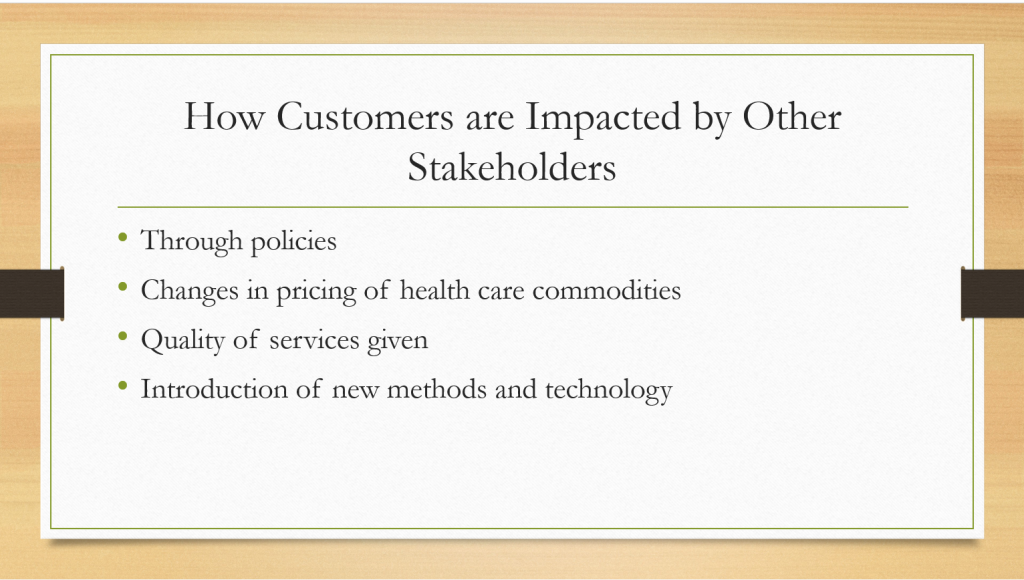
There are several ways through which consumers are affected by other stakeholders. One of the ways stakeholders is through policies formulated by the government. Policies such as Medicaid and Medicare are examples of polices that have been termed to have great impact on access to health care services by consumers (Nejati et al., 2019).
Another way they can be impacted is through changes in pricing of services such as insurance covers, health care technology and medications, among other health car commodities. With changes in pricing either due to market forces or policies, the ability of consumers to afford health care services is also impacted.
Another way consumers are impacted is through the quality of services given by care providers. If the services are substandard, then the level of satisfaction and outcomes will also be low.
Introduction of new methods and technology can also impact consumers for example, the adoption of telemedicine services can affect how consumers receive their services from care providers

The Affordable Care Act (ACA) also known as Obama-care was an act signed into law in 2010 by former US president Barack Obama. The act had two main goals which are to provide better health insurance coverage for Americans and lowering the overall cost of health care services. through the act, 16% of the population who had no access to health care services previously, (those not covered by their employers or national programs) were targeted. Since then the act has been said to bring some transformation in the health care sector (Frean et al., 2017).
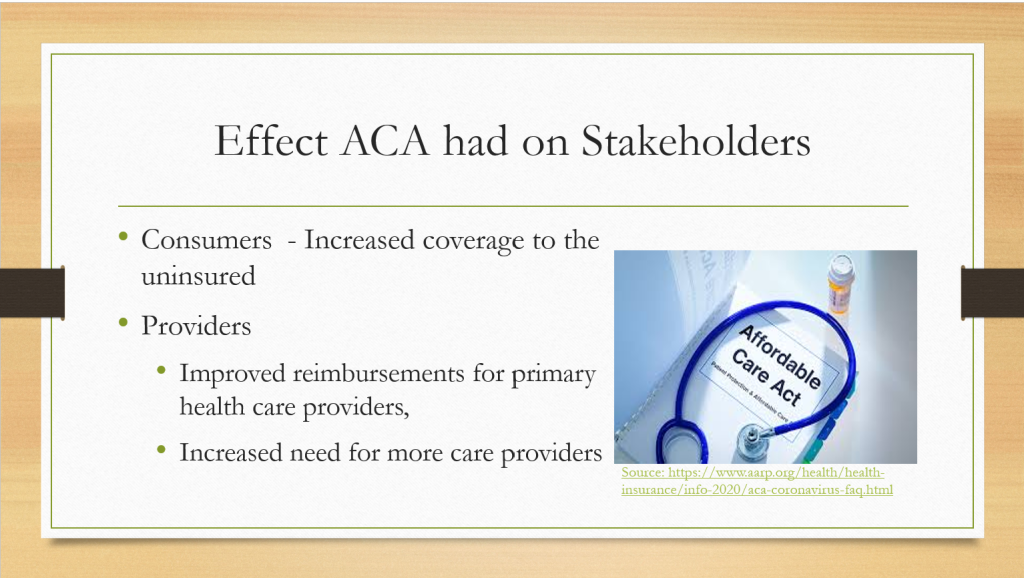
After the enactment of the ACA, the effects were felt by almost all the stakeholders withing the care delivery spectrum. Among those who were majorly impacted are the act are the consumers of health care services. ACA helped to reduce the number of previously uninsured Americans, which led to increased access to affordable care (Kominski et al., 2017). Another stakeholder affected were the primary care providers who, after the enactment of the act were able to receive guaranteed reimbursement rates of no less than 100% reimbursement rates for Medicare and Medicaid services rendered.
In addition, in an effort to improve primary care services, care providers will receive a 10% bonus payment on top of existing Medicare reimbursement rates for Medicare services rendered. Similarly, due to increased coverage by ACA there is an increased need to have more care providers to tend to the patients who are now able to access care.
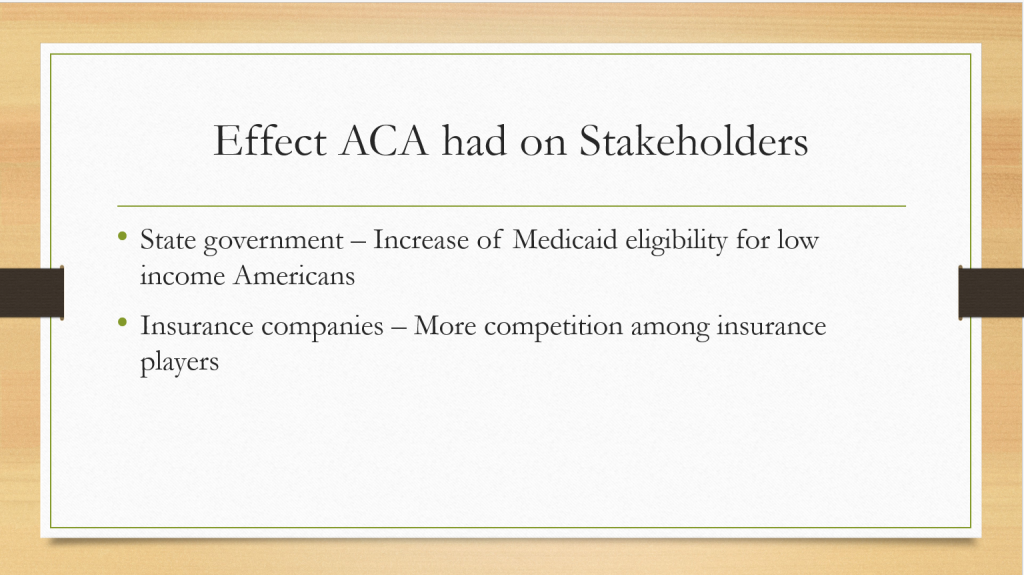
State governments are also affected by the enactment of the act, where by they will be required to increase the eligibility of Medicaid coverage to low-income earners. Thus, to some extent increasing the overall cost of health care expenditure. Insurance companies have also faced an increased competition and may be required to offer better services at competitive prices (Frean et al., 2017).

Nurse leaders have a crucial role to play in making ACA more effective. Some of the strategies they can employ include the following.
One is to be at the forefront in offering information to patients without insurance coverage on offers available through the ACA. Another strategy as dictated by Cleveland et al. (2019), is to attract and retain more care providers to ensure that there is enough personnel to serve the new influx of covered patients. Nurse leaders can also actively encourage interprofessional collaboration with physicians and other care providers to increase efficiency in delivering care to patients.
Nurse leaders can also come up with effective workforce planning that will promote efficiency of the available nursing staff when discharging care to nurses. This will in the short run deal with the insufficient number of nursing staff t tend to the care needs of the ACA beneficiaries.
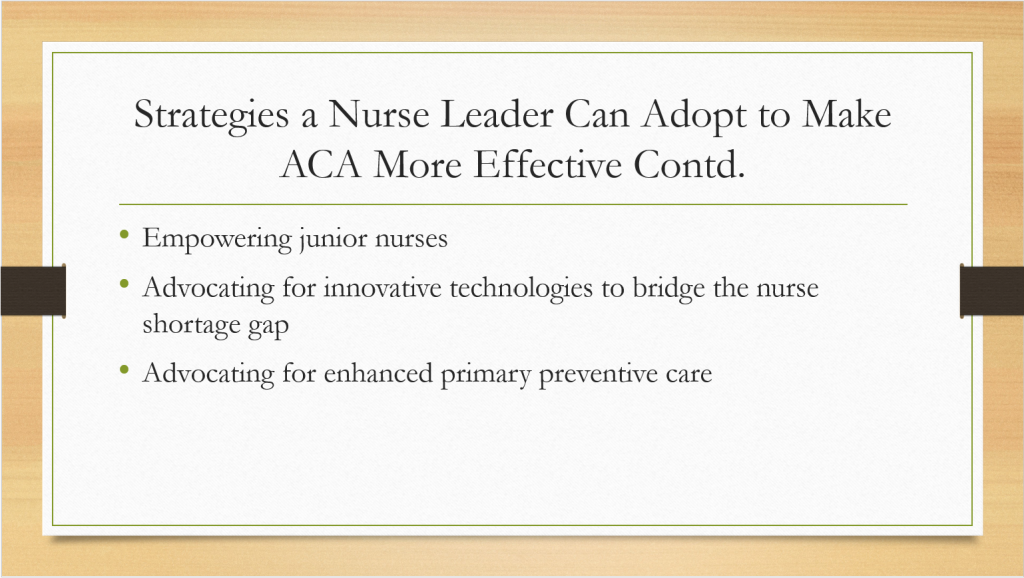
Nurse leaders can also empower junior nurses by encouraging them to discharge care to the full extent of their nursing education. Similarly, nurse leaders should also encourage other nurses to continue advancing their education to improve their competencies and skills in discharging care to patients (Cleveland et al., 2019) Nurse leaders can also advocate for application of innovative technologies as one of the methods to improve workforce efficiency and reach to patients who need health care services. Lastly, nurse leaders can also advocate for enhanced primary preventive care rather than curative care as a means of reducing the burden on the health care system, both financially and human resource.

The nurse leader has a role to share relevant information about a payer with the relevant facility staff for example, other care providers involved in the case, the administrators in charge of billing among others. One of the important information that a nurse leader should share with staff regarding the payer is information reinforcing the need to focus on patient satisfaction. A consumer will be more willing to pay for the services received when they feel that the services were worth it.
Therefore, a nurse leader should emphasize to the staff, especially care providers on the need to ensure that the payer Another important information is the reimbursement model used by the facility. There are different models of reimbursements with the common ones being the fee-for-service model (most used) and the value-based model (Leger, & Dunham-Taylor, 2018).
Therefore, it is important for the nurse leader to inform the staff the one they should use when billing the payer. Another information that the nurse leader should try and remind the staff is to collect payment while the payer is still on site as this is a best practice. The nurse leader should also talk with the staff about policies of collecting payments while payer is still onsite.

A nurse leader should also inform the staff on the feedback received from the payer, especially feedback on the quality of services received (Chang & Hutter, 2019). . This can prove useful in instilling the culture of continuous improvement. The nurse leader should also share information on the patient condition, the reason being that the payment for services vary depending on the type of services given.
For example, a patient needing surgery will be charged differently from a patient visiting for their annual physical check-up. The nurse leader should also inform the staff about the mode of payment preferred by the payer, whether it is through cash or through co-pays with an insurance provider.
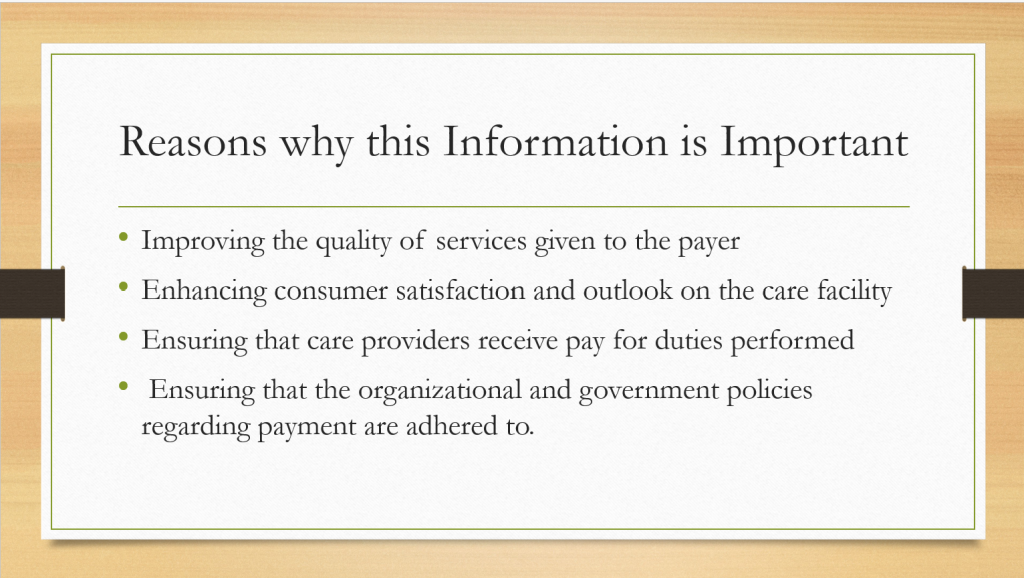
The reasons why a nurse leader should share this information with staff is because this information can assist the staff to improve the quality of care given to patients, for instance, patient feedback on quality of care received (Chang & Hutter, 2019). Another reason is to enhance consumer satisfaction and outlook on the care facility, through quality of services received. This information is also important in ensuring that care providers receive pay for the services rendered to the payer. Lastly, the information can be useful is ensuring that the government and organization policies concerning payment have been followed to the latter.
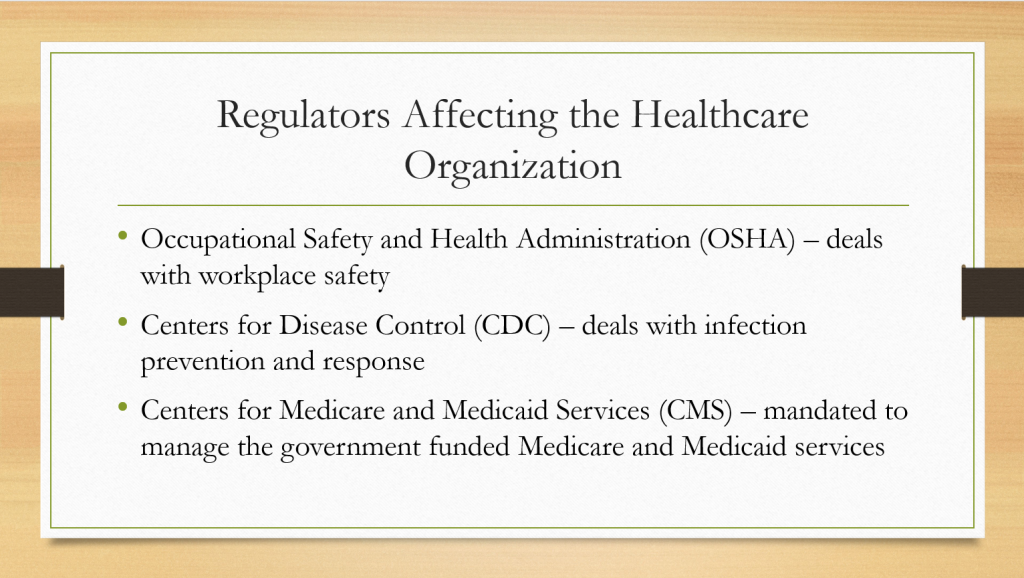
Health care service provision is a field that directly affects the well-being of patients and communities alike and to ensure quality services is given to the consumers it has to be properly regulated. Some of the regulators affecting the health care organization include;
- Occupational Safety and Health Administration (OSHA) – who are in charge of ensuring that employees within the facility operate in a safe workplace.
- Centers for Disease Control (CDC) – who are in charge of infection prevention and response
- Centers for Medicare and Medicaid Services (CMS) –which is a government funded insurance that controls Medicare and Medicaid services

We also have the Food and Drug Administration (FDA) – who regulate food and drugs for safety
Agency for Healthcare Research and Quality (AHRQ) – who are mandated to produces evidence for safer, higher quality care, cost-effective, and data tracking for improvement
The relevant state boards governing different health care providers.

The role of nurses in the respective regulatory processes is as follows;-
Nurses have a role to play in facilitating a safe environment for other nurses to properly discharge their duties.
A nurse also has a role to pay in the regulatory process by discharging the nursing duties to the full extent of the nursing education (Winstead & Moore, 2020).
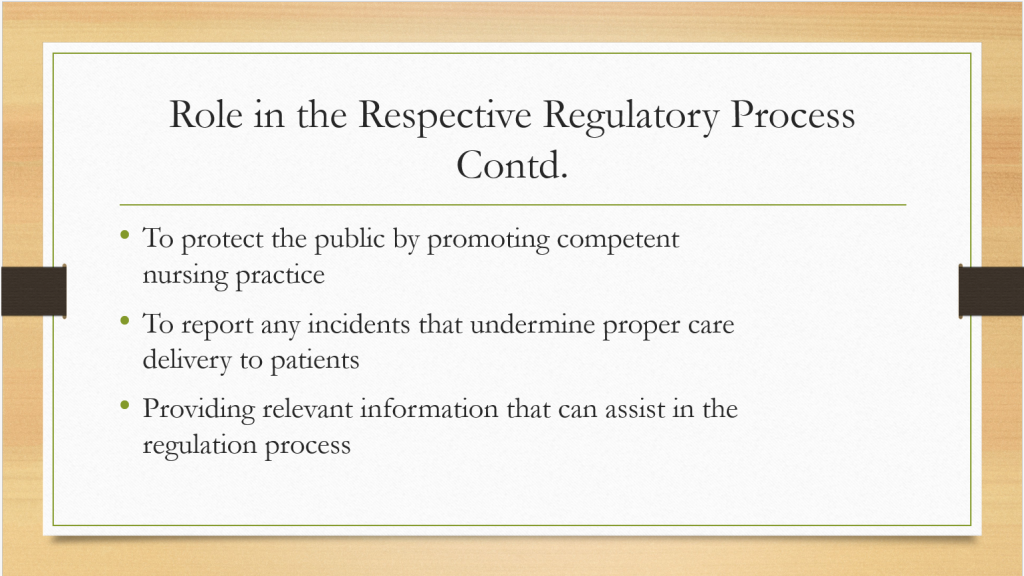
Other than that, a nurse has a role to protect the public by promoting competent nursing practice (Winstead & Moore, 2020).
Also to enhance the regulatory process, a nurse has a role to report any incidents that undermine delivery of proper care to patients.
Lastly, a nurse has a role to provide relevant information that can assist in the regulation process to function as it should.
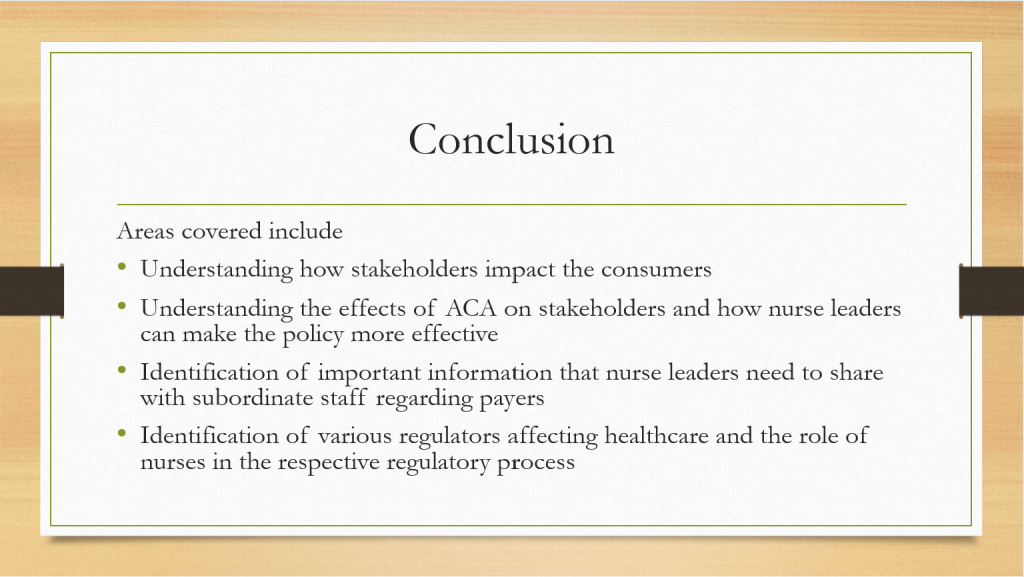
From this presentation several concepts regarding the strategic operation of health care organizations have been discussed.
The presentation has talked about the various stakeholders in health care and how they impact consumers. The presentation has also focused on the effects of ACA on stakeholders and how nurse leaders can make the policy more effective. This presentation has also identified some of the important information that nurse leaders can share with staff regarding the payers of health care services and why the information is important.
Finally the presentation has concluded by analyzing the role of nurses in the respective regulatory process. This information can be useful in assisting nurse leaders to properly and strategically manage health care organizations they work for.
References
- Chang, J., & Hutter, M. M. (2019). Patient Satisfaction, Patient-Reported Outcomes, and Quality. In Quality in Obesity Treatment(pp. 51-57). Springer, Cham. https://doi.org/10.1007/978-3-030-25173-4_7
- Cleveland, K., Motter, T., & Smith, Y. (2019). Affordable care: harnessing the power of nurses. Online Journal of Issues in Nursing, 24(2).
- Frean, M., Gruber, J., & Sommers, B. D. (2017). Premium subsidies, the mandate, and Medicaid expansion: Coverage effects of the Affordable Care Act. Journal of Health Economics, 53, 72-86. https://doi.org/10.1016/j.jhealeco.2017.02.004
- Kominski, G. F., Nonzee, N. J., & Sorensen, A. (2017). The Affordable Care Act’s impacts on access to insurance and health care for low-income populations. Annual review of public health, 38, 489-505.
- Purnell, L. D., & Fenkl, E. A. (2019). Transcultural diversity and health care. In Handbook for Culturally Competent Care(pp. 1-6). Springer, Cham. https://doi.org/10.1007/978-3-030-21946-8_1
- Leger, M. & Dunham-Taylor, J. (2018). Health care financial management for nurse managers: Merging the heart with the dollar(4th ed.). Boston: Jones & Bartlett. (Chapter 2)
- Mazurenko, O., Zemke, D. M., & Lefforge, N. (2016). Who Is a Hospital’s “Customer”?. Journal of Healthcare Management, 61(5), 319-333. rom https://journals.lww.com/jhmonline/Citation/2016/09000/Who_Is_a_Hospital_s__Customer__.5.aspx
- Nejati, M., Razavi, M., Harirchi, I., Zendehdel, K., & Nejati, P. (2019). The impact of provider payment reforms and associated care delivery models on cost and quality in cancer care: A systematic literature review. PloS one, 14(4), e0214382. https://doi.org/10.1371/journal.pone.0214382
- Winstead, J., & Moore, C. M. (2020). Outcomes and Impact of a Nursing Regulatory Orientation Workshop for Nurse Leaders. Journal of Nursing Regulation, 10(4), 22-29. https://doi.org/10.1016/S2155-8256(20)30010-7
Place your order now for a similar assignment and get fast, cheap and best quality work written by our expert level assignment writers.

Use Coupon Code: NEW30 to Get 30% OFF Your First Order
How do healthcare consumers differ from other consumers?
| Aspect | Healthcare Consumers | Other Consumers |
|---|---|---|
| Decision-Making | Often rely on healthcare providers for recommendations | Make independent decisions based on preferences and price |
| Knowledge Level | Typically have limited knowledge of medical services or procedures | Generally more informed about product features and alternatives |
| Urgency of Need | Needs are often urgent or life-dependent | Needs are usually elective or based on desire |
| Price Transparency | Pricing is often unclear or disclosed after services are provided | Prices are usually clear and known before purchase |
| Insurance Involvement | Payments are often handled through third-party insurers | Consumers usually pay directly for goods/services |
| Emotional Involvement | High emotional and psychological stress may influence decisions | Lower emotional involvement in most purchasing decisions |
| Regulations | Heavily regulated industry with strict standards | Regulations vary widely depending on the product or service |
| Customization | Services often tailored to individual medical needs | Standard products/services with optional customization |
| Outcome Uncertainty | Outcomes are unpredictable and not guaranteed | Outcomes are generally predictable based on product specifications |
| Provider Relationship | Long-term trust-based relationship with providers | Often one-time or short-term interactions with vendors |
Who are the consumers of healthcare?
Consumers of healthcare are individuals or groups who use or are affected by healthcare services. They include:
-
Patients
-
Individuals receiving medical care, treatment, or health services.
-
-
Families and Caregivers
-
People who support and make healthcare decisions for patients, especially children, the elderly, or those with disabilities.
-
-
General Public
-
Anyone who uses preventive services like immunizations, screenings, or health education.
-
-
Healthcare Professionals (as secondary consumers)
-
Although they provide care, they also consume healthcare services for their own health and well-being.
-
-
Employers
-
Organizations that purchase health insurance or wellness programs for their employees.
-
-
Insurance Companies
-
Indirect consumers that manage healthcare costs and services on behalf of their clients.
-
-
Government and Public Health Agencies
-
They plan and use healthcare services for populations, such as during disease outbreaks or public health campaigns.
-
-
Educational Institutions
-
Schools and universities that offer health services to students and staff.
-

I am a professional nursing assignment expert offering comprehensive academic support to university nursing students across various institutions. My services are designed to help learners manage their workload effectively while maintaining academic excellence. With years of experience in nursing research, case study writing, and evidence-based reporting, I ensure every paper is original, well-researched, and aligned with current academic standards.
My goal is to provide dependable academic assistance that enables students to focus on practical training and career growth.
Contact me today to receive expert guidance and timely, high-quality nursing assignment help tailored to your academic needs.

